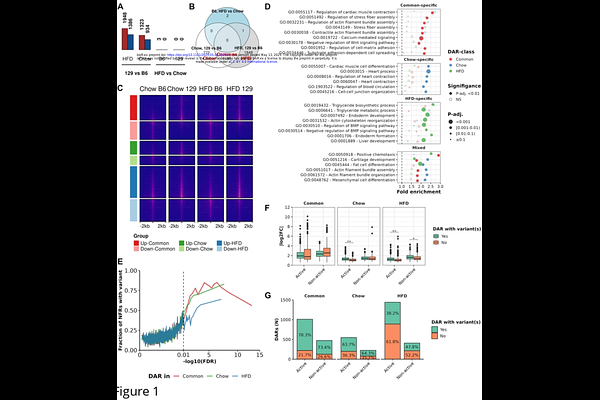Transcription factor occupancy is affected by genetic variation in the white adipose tissue of C57BL6/j and 129S1/SvImJ mice

Transcription factor occupancy is affected by genetic variation in the white adipose tissue of C57BL6/j and 129S1/SvImJ mice
Mononen, J.; Taipale, M.; Malinen, M.; Levonen, A.-L.; Ruotsalainen, A.-K.; Norton, L.; Heikkinen, S.
AbstractMost of the disease associated genetic variants identified in genome wide association studies have been mapped to the non-coding regions of the genome. One of the leading mechanisms by which these variants are thought to affect disease susceptibility is by altering transcription factor (TF) binding. Even though inbred mouse strains have been commonly used to investigate polygenic diseases, less is known on how their genetic differences translate to the level of gene regulation and chromatin landscape. Here, we investigated how genetic variation affects chromatin accessibility, a commonly used proxy for TF binding, and how this relates to gene regulation in the epididymal white adipose tissue (eWAT) of C57BL/6J and 129S1/SvImJ mice fed either chow or high-fat diet. We show that differences in chromatin accessibility are almost exclusively strain-specific and driven by genetic variation. In addition, we integrate ATAC-seq (chromatin accessibility) and H3K27ac ChIP-seq (active regulatory regions) data to show that tissue-specific TFs are commonly found in the active regulatory regions hosting TF binding motif altering variants in eWAT. By incorporating footprint analysis, we also show that TF occupancy is consistent with TF binding motif scores at the genetically altered loci. In addition, we validate these findings by extending the footprint analysis to ATAC-seq and H3K27ac ChIP-seq data obtained from the liver. Also, we employ RNA-seq to show that differentially expressed genes are collocated with differentially accessible regions hosting genetic variants. Overall, our findings highlight the connection between differential chromatin accessibility, TF binding and genetic variation and their role in the gene regulation across metabolically central tissues of a mouse model for polygenic obesity.